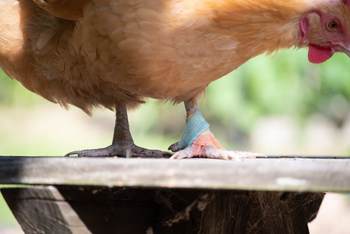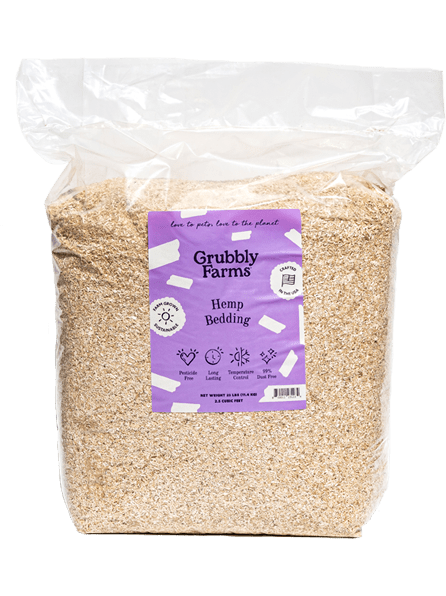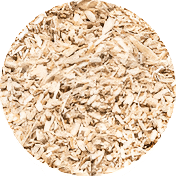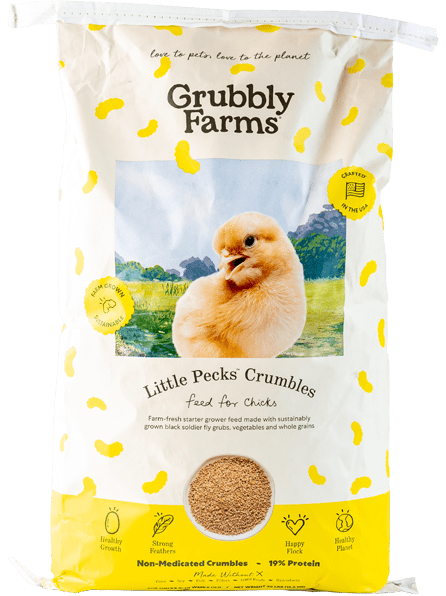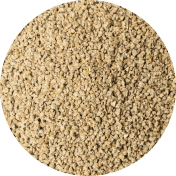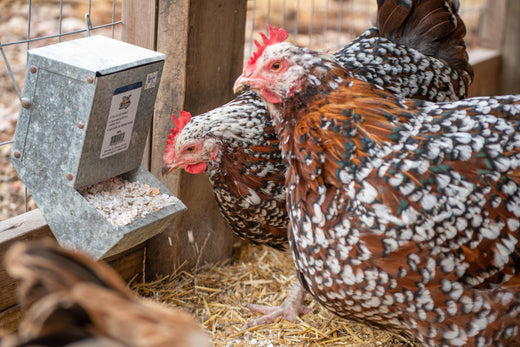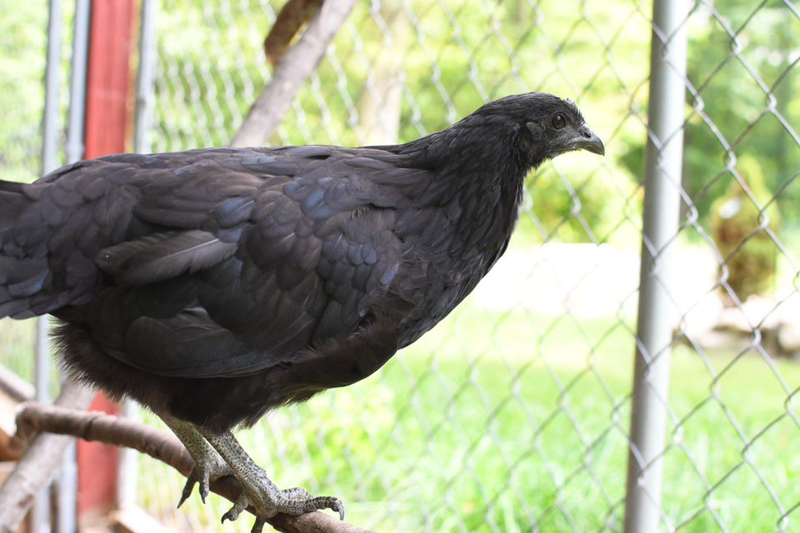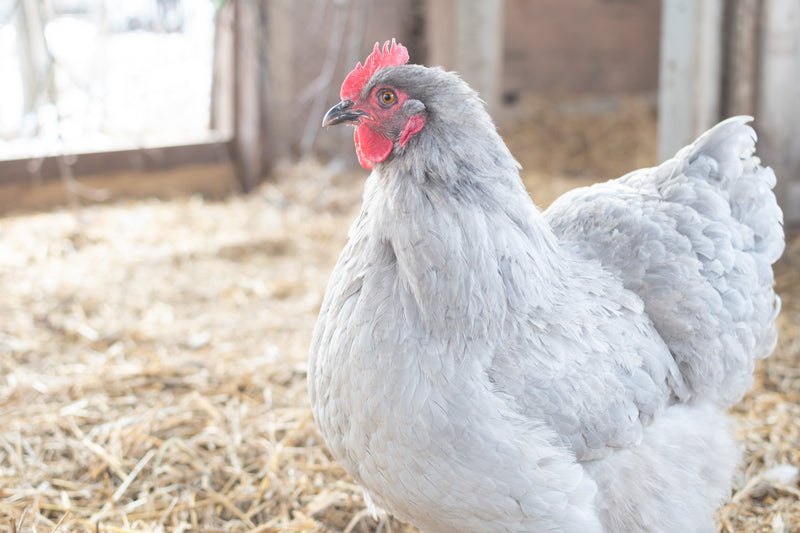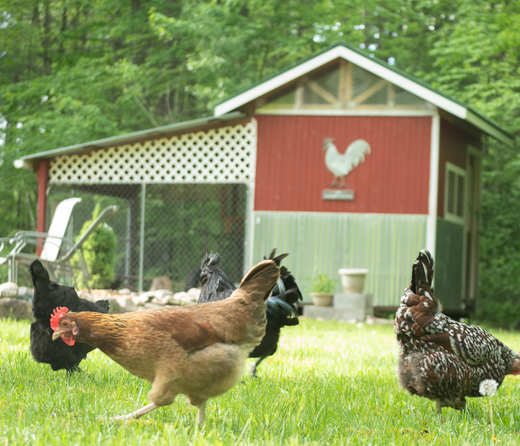Your chickens' feet are key to their health and well-being. Whether they are eating, foraging, or even roosting, they are on their feet all day long. Protecting, preventing, and treating foot and leg injuries can save your flock from discomfort (or worse). Bumblefoot is one of the most common foot conditions in chickens. It’s painful, and if not addressed quickly it can become fatal. Luckily, bumblefoot is a fairly easy condition to diagnose in chickens and can be treated at home or by a vet.
If you’re unsure of what bumblefoot in chickens looks like and how to treat it, this article is for you. We also have some excellent tips on how to prevent this painful injury to keep your flock enjoying life on their feet.
What is Bumblefoot in Chickens?

Bumblefoot is a staph infection that affects a chicken’s foot pad. Bumblefoot can occur in one foot or in both feet at the same time. This staph infection is caused by the staphylococcus aureus bacteria, which can be present on a chicken’s skin and mucous membranes. Whenever there is a cut or abrasion on the skin, the bacteria can enter the wound or scrape and cause an infection to form.
Bumblefoot earned its name because the staph infection causes a hard core to form in the foot pad. The hard core is like an abscess and is sometimes called a ‘bumble’ or a ‘kernel.’
Bumblefoot can affect several species of poultry, including both chickens and ducks. Bumblefoot in ducks can be treated very similarly to how it is treated in chickens as the symptoms are the same for both species.
What Makes Bumblefoot a Serious Infection?
Staph bacteria thrive in the low-oxygen environment of a wound. This allows the infection to grow and spread quickly, becoming quite serious if it is not treated right away.
Bumblefoot can be fatal for a chicken if the infection is left long enough. Without treatment, the infection advances and enters the chicken’s bloodstream. However, fatal bumblefoot infections usually only occur when another ailment or virus has suppressed the immune system enough so that it can’t fight the staph infection.
What Causes Bumblefoot?
Bumblefoot occurs when staph bacteria enter through a chicken’s skin and form an internal infection in the foot pad. However, there are some conditions that can make an infection more likely to occur, including:
- Splinters: Splinters from sharp objects like tree branches, rough boards, or even wood shavings can create cuts or openings in the skin on the foot pad.
- Pressure: Heavy pressure on the foot pad can cause the skin to weaken, which is especially problematic amongst heavier chicken breeds when they have to jump down from high perches onto packed litter or hard ground.
- Rough Forage Conditions: Free-ranging in environments that have rocky ground or other rough terrains can increase the chances of foot injuries.
- Concrete Flooring: Chickens living on concrete or wire flooring are more likely to develop bumblefoot because of the abrasive nature of this material.
- Injuries: Anything that causes an injury or even a bruise on the foot pad can allow the staph infection to enter through the skin.
- Vitamin A Deficiency: A diet without enough Vitamin A causes weakened and flakey skin which can increase the likelihood of injury and infection on the foot pad.
A Flock-Wide Problem vs. Occasional Bumblefoot
If you notice occasional cases of bumblefoot in your flock, the primary cause is likely random injuries the chickens acquired while going about daily activities.
If bumblefoot cases are more frequent in your flock or you notice that several of your birds have bumblefoot simultaneously, you will want to consider if any management issues are causing the bumblefoot cases. Take a closer look at factors like your flock’s:
- Perching conditions
- Diet
- Housing
- Foraging environment
Bumblefoot in Chicks
Bumblefoot can affect both adult chickens and baby chicks. In baby chicks, the most common cause of bumblefoot in chickens is perching at too young of an age. This is because the skin on their foot pads has not toughened up enough or become callused to withstand the pressure of jumping down from perches.
Signs & Symptoms of Bumblefoot
Severe cases of bumblefoot are fairly easy to spot and identify. However, you want to be able to identify even mild cases of bumblefoot so that you can start treating the infection before it becomes advanced.
Mild Bumblefoot Symptoms
- A swollen foot pad: The infected area has filled with pus
- Hotness of the foot pad (use the back of your hand or a finger to judge if the area feels fevery): A sign of infection
- A shiny reddened dot on the foot pad: The beginning stage of the infection lesion
- A small black callus: The internal infection has connected with the surface lesion
Severe Bumblefoot Symptoms
- A large black scab: the surface lesion is growing
- A hardened or hardness of the foot pad: Usually accompanied by a black callus or scab
- A swollen foot pad: The infected area has filled with pus
- Elevated heat radiating from the foot pad: A sign of infection
- Limping & reluctance to walk: The hard ‘kernel’ of infection makes it painful to walk
- Swollen toes & legs: The infection has started to spread into the rest of the foot
How to Treat Bumblefoot in Chickens

The sooner you catch a case of bumblefoot, the easier it will be to treat the infection. For any case of bumblefoot, be prepared to perform some minor surgical tasks or make a trip to your veterinarian to do so. The infection is inside the foot which requires a small cut or incision to be made in order to access the core of the infection. How invasive the surgery has to be is determined by how severe the bumblefoot case is.
While the method of opening the foot pad to treat bumblefoot is commonly performed by backyard chicken keepers, if you feel uncomfortable with the procedure, you want to find a local vet to perform the surgery.
How to Treat Minor Cases of Bumblefoot

In mild cases of bumblefoot, the infection has not progressed enough to create a hard kernel, or abscess, in the foot pad. Mild cases of bumblefoot are characterized by either a shiny, reddened spot on the foot pad or a very small black dot on the foot pad.
Here is how to treat mild cases of bumblefoot in chickens:
Step 1: Gather the equipment you will need:
- Towels
- Paper towels
- A scalpel
- Epsom salts
- Antibacterial spray
- Antimicrobial cream
- Gauze (pre-cut to about the chicken’s foot size)
- Vet wrap
Step 2: Clean the chicken’s feet by rinsing them under warm water and gently scrubbing away any poop if necessary.
Step 3: Fill a shallow bucket with lukewarm water and some Epsom salts. Hold the chicken so that its feet can soak in the warm water for at least 10 minutes. The Epsom salts help relieve any swelling and the warm water softens the skin on the foot pad.
Step 4: Once the skin on the foot pad is soft, you can see if the scab will lift off. If you want to avoid using a scapel, trying multiple soaks of warm water at 10 to fifteen minutes each. If the scab is still not lifting off, you can use a very sharp, sterilized blade (a surgical scalpel or sharp X-Acto knife) to make a small cut in the footpad next to the location of the infection/shiny or black spot.
NOTE: While many backyard chicken owners use this method--you do not have to. Instead, you can contact your vet for assistance.
Step 5: Stop any bleeding if necessary by applying pressure to the area with a clean cloth or paper towel.
Step 6: Spray the cut with antibacterial spray (Vetericyn wound and skin spray is a good option) and apply some antimicrobial cream. Antibacterial and antimicrobial sprays and creams will help fight the infection.
Step 7: Apply some antimicrobial cream to a piece of gauze and secure the gauze over the foot pad by wrapping the foot in vet wrap. To wrap a chicken’s foot, cut a piece of vet wrap that is about ¾" wide and 10” long. Start at the foot pad and begin weaving the wrap in between each of the chicken’s toes, going around the leg (shank) at least once.
Maintaining the Wound Area
Repeat the process of soaking, spraying, and applying cream, and then wrapping the foot every day until the signs of bumblefoot disappear. You don’t need to make a new cut every day since the spray and cream can enter through the initial cut as it heals as well as be absorbed through the skin.
How to Treat Severe Cases of Bumblefoot
Severe cases of bumblefoot will require a little more invasive surgery. In severe cases of bumblefoot, the staph infection has progressed enough to form the hard abscess, or kernel, of infection that is characteristic of bumblefoot. The kernel, or kernels, will need to be removed as completely as possible in order for the bumblefoot to be treated effectively.
Here’s how to treat severe cases of bumblefoot in chickens:
Step 1: Follow steps 1 through 3 above to prep the area and your chicken.
Step 2: Once the skin on the foot pad has softened, begin to gently peel off the black scab (the lesion on the skin from the internal infection). As long as the skin has not broken yet, you can continue to soak the foot until the ‘scab’ is soft enough to peel away. But, once the skin has been broken you will not want to soak the chicken’s feet in Epsom salt-water mix.
If the black scab is not coming off easily, you may need to use a sharp knife or blade to aid the process of removing it (see Step 4 above).
Step 3: Once the black scab has been removed, gently probe the wound to extract some of the yellow pus from the abscess. Use a clean cloth or paper towel to clean away any blood and pus as you extract as much from the wound as possible.
Step 4: After a majority of the pus has been cleared away, gently press the skin apart on either side of the wound and look for hard, yellow kernels. Gently probe the kernels out or use tweezers to remove as many kernels as possible.
Step 5: Clean the wound with warm water and apply an antibacterial spray and antimicrobial cream to the wound. Apply some of the antimicrobial cream to a gauze pad and secure the gauze over the wound by wrapping the chicken’s foot in vet wrap.
Ongoing Wound Care
Continue to remove pus and kernels from the wound for the next 2 to 3 days. Clean and rebandage the wound after each surgery. Don’t soak the chicken’s feet in Epsom salts while the wound is still open.
After 2 to 3 days of extracting as much of the infection as possible, allow the wound to heal. Continue to spray and apply the cream as the wound heals, wrapping the foot after each application of spray and/or cream.
Caring for a Chicken After Bumblefoot Treatment

After a chicken has undergone surgery for bumblefoot treatment, you will need to take special measures. These post-treatment steps ensure the wound stays clean and does not become further infected.
In cases of mild and severe bumblefoot, replace the bandages and monitor your chicken’s foot daily until the exterior wound heals.
Post-Care for Mild Bumblefoot
In the case of a mild bumblefoot treatment, you may be able to return the chicken to the flock each day after treating the infection. As long as you adequately and securely wrap the wounded foot in vet wrap you can allow the chicken to rejoin the flock after each treatment. Just make sure the bandage won’t come off which would then allow the small wound to get dirty and worsen the infection.
After returning the chicken to the flock, make sure the other flock members don’t bully the chicken, especially if they are intrigued by the bandage around her foot. If they show too much interest in the wounded chicken, you may have to keep her quarantined in an infirmary pen while she heals.
Post-Care for Severe Bumblefoot
In the case of more invasive surgery due to severe bumblefoot, the chicken will have to stay quarantined in an infirmary pen while she heals. The wound created by treating severe bumblefoot is large and needs to be kept clean to prevent further infection.
Once the wound has adequately healed and scabbed over, you can re-introduce the hen to the flock. She may still need her foot bandaged just to prevent the scab over the wound from being damaged or re-opened. Remember to make sure the hen doesn’t get picked on by the others as she rejoins the flock.
You will no longer need to bandage the foot once the scab has completely healed.
Setting Up Your Chicken’s Infirmary Pen
When setting up an infirmary pen, use plenty of thick, soft litter (wood shavings work well), fresh water, and plenty of food.
Don’t include any roosts in the infirmary pen or anything that the hen might be able to jump up on.
Clean up any droppings in the infirmary pen as frequently as possible to keep the bandaged foot clean.
How to Prevent Bumblefoot in Chickens
Bumblefoot is no fun for anyone, so taking preventative measures is the best way to minimize the chances of having to deal with bumblefoot in your flock. Luckily, preventing bumblefoot is easy if you just consider the main issues that cause bumblefoot.
The best way to catch bumblefoot before it becomes too severe is to do a monthly health check on all the birds in your flock. Once a month, look each bird over and check their feet for early signs of bumblefoot. Look for bruises, scabs, cuts, and swelling. If you notice a pattern among your chickens, address their diet and environment. If just one chicken may be developing bumblefoot, monitor them closely.
Additionally, you can prevent bumblefoot in your backyard flock by:
- Providing Proper Roost Height: If you have larger chicken breeds that are heavy, make sure the roosts are no more than 2 to 3 feet off the ground. If you have a mixed flock of both light and heavy chicken breeds, consider providing a variety of high and low roosts to please everyone.
- Creating Ramps & Ladders: Provide ramps or ladders that will help heavier chickens access the roosts while getting up and coming down.
- Using Soft Litter: Use soft litter in the coop and ensure it stays loose and fluffy.
- Preventing Splinters: Sand down roosts to remove wood splinters and clean the roosts to minimize bacteria build-up. You can do the same for all the perches in the chicken coop and enclosure as well.
- Sticking to Proper Roosting Age: When raising chicks, make sure they are at least 4 weeks old before providing any roosts or perches.
- Offer Fermented Feed: Fermented chicken feed naturally provides probiotics for strengthening the immune system and fighting off infection.
- Feeding a Proper Diet: Make sure you are giving your flock quality chicken feed that provides them with all the nutrients and vitamins (including Vitamin A) they need.
Keep Your Flock on Their Feet

Bumblefoot is a relatively common staph infection that can infect nearly any chicken. However, this issue can be easily prevented with proper bedding, a clean coop, monthly checks, and a healthy diet. And should one of your birds suffer from the dreaded bumblefoot, you can treat your hen at home.
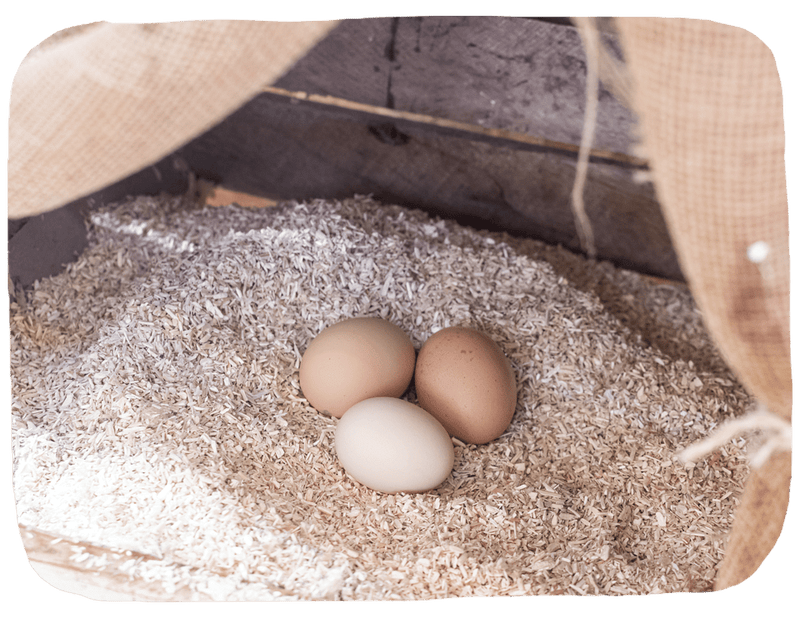
Hemp Bedding
All Natural, Pesticide Free Bedding
Hemp is highly absorbent, odor-resistant, compostable, easily sifted, and a natural insect and fungi repellant. It also lasts longer than traditional bedding materials, requiring less frequent changing.
Shop NowDon’t let your girls suffer from a Vitamin A deficiency. Fresh Pecks layer feed is formulated with optimal Vitamin A and all the other nutrients your girls need for strong immune systems and happy lives.





